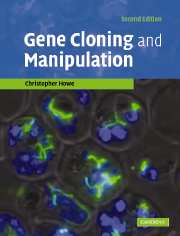Book contents
- Frontmatter
- Contents
- Preface to first edition
- Preface to second edition
- Chapter 1 The tools for the job
- Chapter 2 Polymerase chain reaction
- Chapter 3 Simple cloning
- Chapter 4 Other vector systems for E. coli
- Chapter 5 Making libraries
- Chapter 6 Screening libraries
- Chapter 7 Modification and mutagenesis
- Chapter 8 Use of cloned DNA
- Chapter 9 Using other organisms
- Chapter 10 Examples
- References
- Index
Chapter 9 - Using other organisms
Published online by Cambridge University Press: 05 June 2012
- Frontmatter
- Contents
- Preface to first edition
- Preface to second edition
- Chapter 1 The tools for the job
- Chapter 2 Polymerase chain reaction
- Chapter 3 Simple cloning
- Chapter 4 Other vector systems for E. coli
- Chapter 5 Making libraries
- Chapter 6 Screening libraries
- Chapter 7 Modification and mutagenesis
- Chapter 8 Use of cloned DNA
- Chapter 9 Using other organisms
- Chapter 10 Examples
- References
- Index
Summary
Introduction
So far, we have concentrated on the techniques for manipulating the genome of E. coli. However, it is very likely that we will need to work with other organisms, too. We might be interested in some aspect of the biology of another species and want to study the effect of modifying it in some way. We might want to make genetically altered versions of commercially important species, such as crop plants, to improve their value. Or we might want to produce a protein in a form that requires some post-translational modification that E. coli is unable to accomplish. The principles that we have seen for E. coli apply in exactly the same way. We need to have suitable vectors, a means of getting the DNA into the organism and ways to select transformants. We may also need to take steps to increase expression. Often, we first clone DNA from one organism in E. coli and identify a recombinant containing a particular gene of interest. We then transfer that gene into some other host species to alter the host's properties. An organism containing a gene derived from elsewhere is said to be transgenic.
In this chapter we will look at the vectors and transformation systems available for a range of other organisms. We will look first at bacteria, and then we will consider fungi, plants (including algae) and animals.
- Type
- Chapter
- Information
- Gene Cloning and Manipulation , pp. 182 - 242Publisher: Cambridge University PressPrint publication year: 2007



